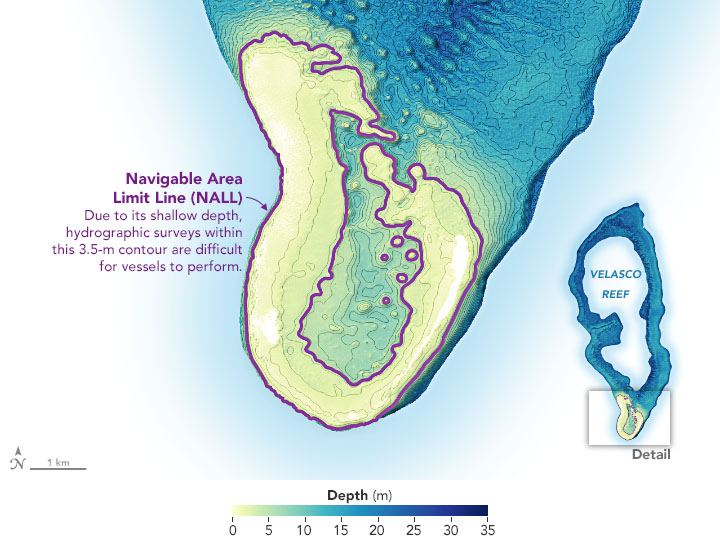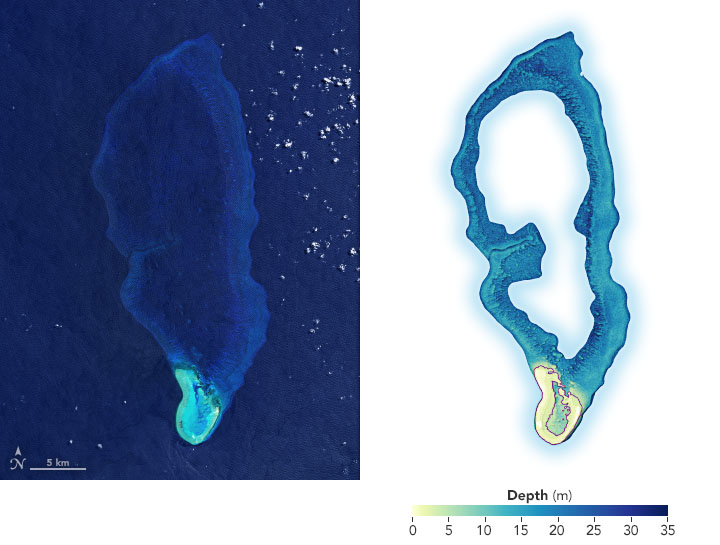Velasco Reef in the Republic of Palau
NASA Earth Observatory images by Joshua Stevens, using Landsat data from the U.S. Geological Survey and data from the Shallow Bathymetry Everywhere project.
Velasco reef with the GeoGarage platform (NGA nautical raster chart)
The waters along the world’s coasts and islands are incredibly important to human activities, yet they are not always well mapped.
Coastal waters are often turbulent and murky, as the sand, mud, and sediment on the bottom is constantly in motion.
Unless there are regularly dredged channels, it can be difficult and dangerous for ships to travel in shallow water.
Making accurate and up-to-date depth charts is time-consuming and expensive, and doing so on a global scale is a monumental task.
By combining satellite measurements with ship-based sonar data, a team of researchers is now working to fill the gaps in our seafloor maps.
They are using data from NASA’s Ice, Cloud, and land Elevation Satellite 2 (ICESat-2) to accurately measure the depths (bathymetry) of shallow coastal waters, where surveying ships have historically been unable to travel due to safety, expense, or remoteness.
The images above show Velasco Reef in the Republic of Palau.
The left, natural-color image of the South Pacific reef was acquired by Landsat 8 in 2020; the right image is a digital elevation model created with ICESat-2 data.
The map was developed as part of a demonstration study led by remote sensing scientists Lori Magruder of the University of Texas at Austin and Chris Parrish of Oregon State University.
They partnered with the Coral Reef Research Foundation in Palau to fuse existing sonar data with their ICESat-2 dataset.
Mapping shallow, nearshore areas can be slow and potentially dangerous. Conventional field methods may involve a surveyor standing in shallow water, taking measurements at specific intervals, while at the mercy of waves and currents.
Meanwhile, boat-based sonar surveys are inefficient in shallow waters and subject to the dangers of waves, rocks, and reefs.
In addition, the National Oceanic and Atmospheric Administration (NOAA) has established Navigable Area Limit Lines (NALL), which define the shoreward limit of their boat-based surveys. The NALL is set at water depths of 3.5 meters (11 feet), and NOAA advises caution to captains maneuvering in shallow areas within the NALL because they are not often mapped, if at all. Sometimes the NALL limit can extend significant distances from shore.
These challenges result in many nearshore coastal waters being largely unmapped.
The area is nicknamed “the white ribbon” because it appears as white space hugging coasts, shoals, and atolls on bathymetric maps.
It essentially represents no data.
“The near-coastal area from 0 to 10 meters in depth is notoriously hard to map because a lot of the acoustic sensors that are used in bathymetry do not capture the shallower depths accurately,” said Magruder.
“Near-shore measurements provide a window into the coastal dynamics and processes that are really important.”

The maps above show the NALL regions around Velasco Reef and the current water depths as measured by Magruder and Parrish’s team. This use of ICESat-2 data could be a game-changer.
The satellite’s main instrument is the ATLAS altimeter, which sends 10,000 laser pulses per second toward Earth’s surface and detects the photons that return in order to determine the height of landmasses and features on it (such as ice sheets, forests, and glaciers).
It turns out that ICESat-2’s laser pulses can also penetrate the water column in shallow areas and return measurements from the seafloor.
The main mission of ICESat-2 is to map sea ice thickness and ice sheet elevation, as well as the height and density of temperate and tropical forests.
Scientists and engineers thought it might be possible to measure ocean bathymetry, but they were not sure until Adrian Borsa, a geodesist at the University of California, San Diego, noticed in 2018 that ICESAT-2 data was picking up seafloor signals around Bikini Atoll in the South Pacific.
This finding provoked Parrish and Magruder to make a concentrated effort to use the satellite for near-shore mapping.
Because it can observe across the entire globe, ICESat-2 provides broader spatial coverage than sonar-mapping ships.
The satellite also collects data from the same location every 91 days, allowing for repeat mapping of areas that previously took great effort to map even once.
Beyond Velasco Reef, researchers are using the novel dataset to map near-shore habitats off of Western Australia and around the Gilbert Islands, French Polynesia, Turks and Caicos, and the Bahamas.
The methods are even being used to map the shores of Lake Tahoe, California.
With a complete and continuous look at near-shore bathymetry, researchers can aid efforts to monitor endangered coral reefs and coastal mangroves, sediment transport after disaster events, carbon storage capacity, water clarity, invasive species, and several other aspects of coastal dynamics.



No comments:
Post a Comment